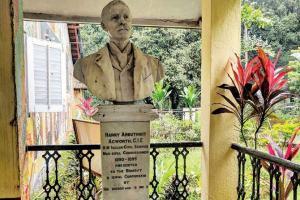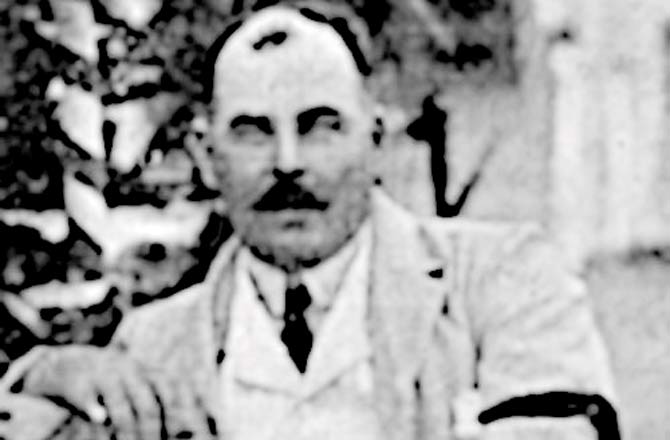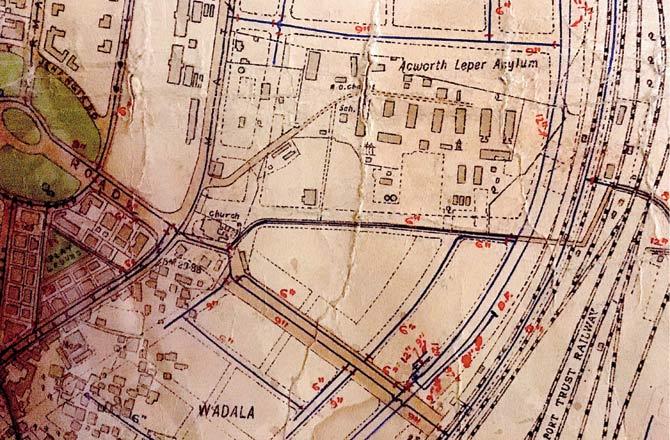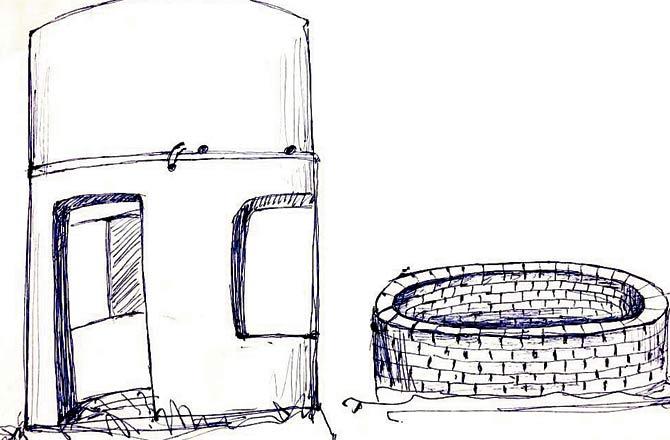Renewable energy came to Mumbai as early as 1901, thanks to a bio-gas plant set up in the Acworth Leprosy Hospital. More than a century on, it's time to bid goodbye

Bust of Harry Arbuthnot Acworth, C.I.E. (1849-1933), Municipal Commissioner from 1890 to 1895 who established the Homeless Leper Asylum in Matunga, today the Acworth Municipal Hospital for Leprosy
A poineering innovation in the quest for renewable energy will soon lose a landmark first made in Mumbai. The site of one of the world's first successful bio-gas plants — built in 1901 by British civil engineer Charles Carkeet James (1863-1942) — will be cleared in the coming weeks for a new medical students' hostel to be built at Matunga's historic Acworth Municipal Hospital for Leprosy.
C C James was a sanitary and drainage expert from Cornwall, fascinated by problems of waste disposal in tropical conditions, where organic matter decomposed rapidly. His techniques for extracting combustible gas from sewage using airless composting are used in cities across the world today. After coming to Bombay to design the Tansa Dam pipeline network to increase water supply to the Island City in 1889, James was deputed by Municipal Commissioner Harry Arbuthnot Acworth to work on the drainage of the new Homeless Leper Asylum in Matunga.

Sewage farm and pump station at Matunga in 1934, photo by Professor Gilbert J. Fowler, Indian Institute of Science, Bangalore, from "An Introduction To The Biochemistry Of Nitrogen Conservation" (Photo circa 1934 from archive.org)
A suburban home
Founded in 1890, in response to public panic of contagion from destitute lepers begging on the streets of Bombay, seven wards for 300 inmates were built on the site of an old rifle range, through public subscriptions led by industrialist Sir Dinshaw Petit. With no existing drainage network on the sloping ridge, the colony's sludge soon overflowed the sinks and cess pits James first built near the villages of Gowari, Khara and Wadala. Already fearful of the lepers, villagers threatened to file a suit against the commissioner for pollution in 1893.
Acworth quickly authorised purchase of all the barren land below the ridge, encouraging James to try out new methods of drainage, purification and recycling. James redesigned its dry latrines to flush and filter the asylum's "night soil" through a new system of tanks, wells and lifting wheels. By 1895, 20,000 gallons of effluent were purified daily through filters and beds made of lime, coal and burnt brick, then pumped to the low-lying plots south of the asylum, to irrigate an experimental farm.

Charles Carkeet James, M. Inst. C.E. (1863-1942), sanitary and water engineer to the Bombay Municipal Corporation, (Photo circa 1902 from irishwaterwayshistory.com)
Paid and fed, but compelled to work on the sewage farm, within three years, the lepers had regenerated six acres of what had been "stiff yellow clay" with rotating crops of jowar, vegetables, and fruit trees and fodder grass, fertilised by their own purified excrement. The farm provided food for the asylum and for sale in municipal markets, as well as to feed bullocks and horses in the city's many stables, on whom Mumbai's local transportation then depended.
Bombay bio-gas
Buoyed by the farm's success, James continued his research into sewage purification and capturing "septic gas" for energy. The most promising new filtration method was designed by Col Walter Mardon Ducat, a retired Royal Engineer who had worked for the Bombay Port Trust and Poona Municipality in the 1870s. James re-fitted three septic tanks in Matunga with new bacterial filters which Ducat had just patented in Europe and America. In 1901 he visited England to observe how heating and lighting was being powered by "gasification" of solid waste in Exeter and Manchester.

Acworth Leprosy Museum, Major R. Parameswaran Marg, next to SIWS College, started in 2009 as by the Acworth Municipal Hospital for Leprosy and the Hospital’s Society for Research Rehabilitation & Education in Leprosy. Open to the public on weekdays from 9 am to 3 pm. Pic courtesy/Shekhar Krishnan
He returned to Bombay and sealed one of the farm's septic tanks with an air-tight cover made of galvanised iron. Bacteria digesting the sludge in the airless tank produced a mix of methane, hydrogen and nitrogen. James harvested India's first bio-gas in Bombay after the monsoon in 1902. It was drawn through a one-inch underground pipe from the sealed tank into a 4x5 foot iron holder, chained to pillars and submerged in an old well. As gas was pressurised into the floating holder, it was piped out to an engine.
At first the engine could only drive a central pump for lifting effluent through the asylum's drainage network, and it took further research and tinkering for James to perfect his invention. The inmates' controlled diet allowed James to closely study the bio-chemistry of their digestion. He discovered the amount of bio-gas needed to generate one foot of horse-power was about double that of coal-fired gas and adapted his engine.

Acworth Leper Asylum, Wadala and Gowari Villages in the 1920s (Map from Hydraulic Engineer's Department Survey Sheets, Municipal Corporation of Greater Mumbai)
Within a year, his plant was producing 100 cubic sq.ft. of purified bio-gas every eight hours, more than enough energy for all the needs of the asylum. By 1905, bio-gas mantle lamps lit the entire asylum grounds and wards, as well as streets and lanes in Matunga and Wadala — neighbourhoods illuminated much before other parts of the Island City. The gas works drove eight ring stoves for cooking in the hospital kitchen, eliminating the need for firewood. More than a hundred more lepers were admitted to newly constructed "James Wards", built from the profits of the farm and gas works.
"Drainage of the East"
In 1906, C.C. James was transferred to Egypt to work on the drainage of Cairo and the Suez Canal, for which he was one of the last foreigners knighted by the Ottoman Sultan. He returned to private practice in London in the years between the world wars.

Drawing of the original condition of the Matunga Bio-Gas Works sketched in November 2018 by Dr Waman S. Bhatki, former Superintendent, Acworth Municipal Hospital for Leprosy (Courtesy Acworth Leprosy Museum)
In Bombay, his gas works ceased operation sometime in the 1930s, after the Improvement Trust acquired the neighbouring villages for new residential housing, and the BEST and Bombay Gas Company brought electricity and piped gas to Matunga and Wadala. James' and Ducat's techniques of filtration and disposal were implemented in the municipal purification works and sewage outfalls built in the 1940s in Dadar and Dharavi, which made possible flushing toilets, multi-story housing, and the northward march of suburbanisation.
The farm continued to yield food and daily exercise for the lepers, whose numbers peaked in the 1960s and have now dwindled to fewer than a hundred, with widespread eradication of leprosy in India. Though James' gas works — hidden in trees behind a wall on the western end of Wadala Bridge — will soon disappear, his innovations in clean energy are richly documented at the Acworth Leprosy Museum on the hospital grounds, today a lush urban forest. As he noted in his report to Commissioner Acworth in 1902, "at Matunga, the ordinary passer-by has no idea that the green plots he sees are being daily irrigated with 20,000 gallons of sewage effluent, for there is no nuisance".
Dr Shekhar Krishnan (@bombayologist) is a social scientist and historian who does research for Greater Mumbai Municipal Corporation (MCGM)
Catch up on all the latest Mumbai news, crime news, current affairs, and also a complete guide on Mumbai from food to things to do and events across the city here. Also download the new mid-day Android and iOS apps to get latest updates
 Subscribe today by clicking the link and stay updated with the latest news!" Click here!
Subscribe today by clicking the link and stay updated with the latest news!" Click here!









